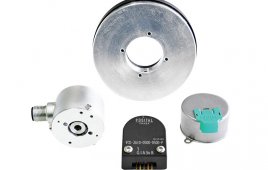
Absolute rotary encoders can provide precise measurements without losing track of position. (Image courtesy of Posital Fraba)
Rotary encoders are often one of the least discussed components of a wind turbine and yet they are integral to many related applications. Encoders are an electro-mechanical device that converts the angular position of a shaft or axle to a digital code.
Three of the most common uses for encoders in turbines are: monitoring and controlling blade pitch, monitoring yaw position or nacelle rotation, and monitoring the speed of the low-speed shaft (rotor RPM) or the high-speed shaft (generator RPM). The first two applications are accomplished with either incremental or absolute encoders, and the third typically uses an incremental encoder.
“But that’s not everything,” said Chuck Juda, Business Development Manager of PepperL+Fuchs, an automation company. “Beyond these applications, encoders can also apply to safety and service-related sub-systems within a turbine, including cable-twist monitors, equipment hoists, and tower man-lifts.”
Juda said it’s important to select an encoder based on the product’s specification to ensure it fits the intended application. “Typical environmental specifications for nacelle components are much broader than those of standard factory automation devices.”
A few key attributes to consider when choosing encoders include: electrical characteristics (e.g. operating voltage and output configuration), storage and operating temperature and humidity, shock and vibration resistance, maximum shaft load, angular resolution or pulse count, and rated bearing life. Lightning protection is also an important feature.
“Many wind turbine OEMs now prescribe specific measures or specialized test procedures to protect an encoder’s internal electronics from lightning damage and from electromagnetic interference.”
Christian Fell agrees. He heads up Posital Fraba North America, a company that designs and markets precision sensors for industrial applications. “Wind turbines can present harsh environments for instrumentation, including extreme temperatures, moisture, salt water, and dust. Encoders should carry ingress protection ratings of IP67 or better.”
To increase longevity and reliability, magnetic encoders provide OEMs with a newer option over the conventional optical or glass-disk devices, which use a light source and photo-detector array to read optical patterns and place positions.
“Magnetic encoders are appealing because they are based on Hall-effect sensors, which eliminate any need for mechanical contact between sensing elements. This reduces wear from vibration and prolongs life,” said Fell. A Hall-effect sensor is a transducer that varies its output voltage in response to a magnetic field. It is used for positioning. “For absolute sensors, the use of a non-linear magnetic effect to power a revolution-counter can add multi-turn capabilities without the need for backup batteries or complicated gear sets.”
Another updated feature to consider is an encoder’s ability to interface and communicate with other turbine components. “Encoders with interfaces that are compatible with the turbine control system will simplify installation and maintenance,” said Fell. “For example, some advanced control systems optimize energy production by noting and slightly adjusting a blade’s pitch when it passes in front of the support tower.”
The trend towards greater integration of sub-systems inside the nacelle is also driving the use of more network-compatible devices, replacing the dedicated point-to-point interconnections of the past.
“This lets multiple processing devices use the encoder information, including those that communicate with remote monitoring systems,” explained Juda. “The ability to directly ‘read’ the encoder’s outputs from a remote location significantly increases the level of preventive diagnostic monitoring and troubleshooting that are possible today.
Filed Under: Encoders




